Al-Subiyah, Mugheira (Kuwait)
Dates: 29 October – 4 December 2008
Team:
Prof. Piotr Bieliński, director of the Polish team (PCMA)
Sultan Ad-Duweish, director of the Kuwaiti team (Department of Antiquities and Museums of the State of Kuweit)
Dr. Łukasz Rutkowski, field director (PCMA)
Dr. Arkadiusz Sołtysiak, anthropologist (Institute of Archaeology, University of Warsaw)
Dr. Dariusz Szeląg, archaeologist (Institute of Archaeology, University of Warsaw)
Dr. Magdalena Żurek, archaeologist (Institute of History, Podlaska Academy)
Maciej Makowski, archaeologist (Polish Academy of Sciences, scholarship holder)
Marta Momot, documentalist (PCMA)
Andrzej Reiche, archaeologist/photographer (National Museum of Warsaw)
Urszula Wicenciak, archaeologist (Pułtusk Academy of Humanities)
Łukasz Wojnarowicz, archaeologist (freelance)
Following up on last year’s survey the team returned to the northwestern part of the Mugheira Well Field Area to excavate five graves: SMQ 30, SMQ 33, SMQ 35A-B, SMQ 38 and SMQ 45 (see As-Sabiyah, in the PCMA Newsletter 2007) and three unidentified stone structures SMQ 36, SMQ 37 and SMQ 44. The second focal point of the excavations was a large, round structure of stone (SM 12) discovered by Sultan Ad-Duweish from the Kuwaiti Depart ment of Antiquities and Museums. This structure, located some 3 km to the west of the excavated burial mounds, proved to be a large desert well. A limited survey and mapping of burial sites was also continued along the southeastern edge of the rocky escarpment of Jal Az-Zor. It focused on a sector to the west of the Dubaij Well, on the outskirts of an area previously surveyed by a team of British archaeologists and Kuwaiti colleagues.
Stone tumuli on a rocky outcrop
Excavations of tumulus SMQ 30, which were started last year, were now completed, leading to revised documentation and a rethinking of the early conclusions concerning burial practices.
A mantle of loose stones of different sizes formed a small, rounded mound approximately 6 m in diameter and 0.70 m high. It concealed an oval grave chamber surrounded by two rings of sandstone slabs. The outer dimensions of the outer ring are about 3.60 m N-S by 3.30 m E-W. The slabs are up to 1 m long and 0.50 m wide. The space between the outer and inner ring, about half a meter wide, was densely packed with smaller stones. The inner ring delimiting the burial chamber consisted of four to five courses of 0.07-0.10 cm thick sandstone slabs, each slab being 0.30–0.40 m wide and rising to a similar height. The slabs were laid flat, tightly fitted without the use of mortar, the long sides facing the inside of the chamber. The grave chamber, which measures 1.20–1.30 m across, was constructed on a paving of sandstone slabs.
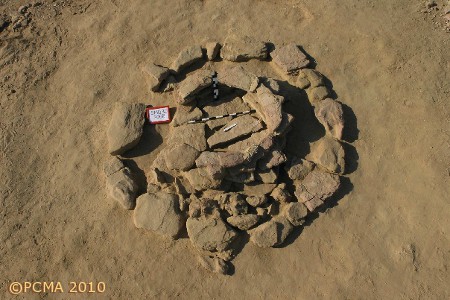
The human bones inside the grave chamber turned out to be in situ, but damaged by a previously unnoticed robbery pit. They belonged to at least two adult individuals, one of them a female (for the anthropological analysis, see Bioarchaeology of the Near East). The burial still in place appears to have followed an NE-SW orientation. The body may have lain on the left side, legs flexed, head to south and facing west, arms bent at the elbows, the hands raised to the face. Small bone fragments and teeth were mixed with a huge quantity of beads and ornaments, altogether 600, found in the fill of the pit and scattered between the covering stones. These adorn ments were made mainly of seashell, shell or mother-of-pearl and stone, but there was also a real pearl and a copper alloy ring. They may have been strewn over the grave at a funeral ceremony.
While the shell ornaments from SMQ 30 are characteristic of Ubaid-period sites in the Gulf Region, the mother-of-pearl pendant found in 2007 season and the copper alloy ring appear to contradict a date in the 6th–5th millennium BC. The ring, however, was found well outside the outer ring of stones and could be misleading as a dating piece of evidence.
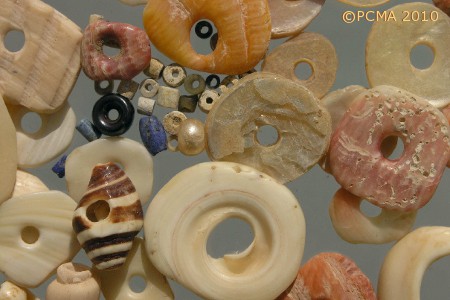
Tumulus SMQ 33 proved to be interesting solely because of the details of its construction. In this case, the builders paved the burial chamber with four layers of flat large slabs. This may have been necessitated by the soft sandy substrate on which the tumulus was erected, unlike the other excavated graves which are all on solid rock. A ring of upright slabs on the fringes of the mound may have formed a framework to prevent the stones of the coating from slipping. An inner ring of tightly fitted stones delimited a virtually round burial chamber (approx. 1.50 m in diameter). The walls were about 0.50 m high, the topmost course starting to move inward apparently as a form of chamber roof. The mound itself reached 6.50 m in diameter and approximately 0.70m in height.
Robbers had left little of the original burial — just tiny fragments of human bones (belonging probably to an adult female) and a few personal adornments, all of them made of shell except for a spacer bead made of stone. None of these ornaments were found among the stones of the mantle.
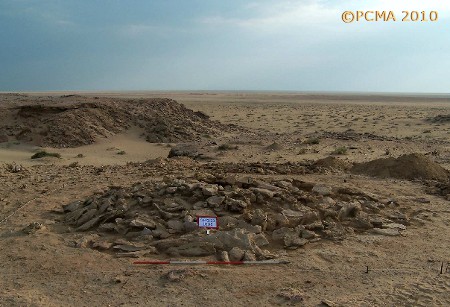
Another group of four stone tumuli lies to the north of the two graves described above. Two adjacent tumuli, SMQ 35A and SMQ 35B, were explored this season. SMQ 35A is the bigger of the two; it measures c. 7.50 m in diameter and about 0.70 m in height. The oval burial chamber (c. 1.80 by 1.50 m) was constructed directly on an uneven bedrock surface and had once been covered with flat, partly superimposed stone slabs. At least four persons were buried in it. The chamber was reopened already after the decomposition of soft tissues.
Interestingly, there were practically no grave goods to speak off in the quarter of the mound that was excavated this season. Apart from the human bones, the only finds were animal bones, a stone bead and a few badly eroded fragments of bronze or copper items. The latter, assuming they were actually connected with one of the burials, would make the inhumation not earlier than the Bronze Age.
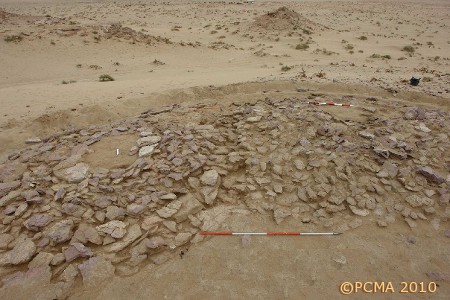
The adjacent tumulus SMQ 35B is almost circular in plan, the maximum diameter being 5 m and the height 0.50 m. Again there were two concentric rings of large stone slabs, the inner one delimiting the burial chamber. The latter was nearly round (max. diameter 1.50 m) and approximately 0.30 m deep, the bottom lined with cobble-sized chunks of rock and large slabs of stone lying on bedrock. It had been opened in the past, which may explain why there were no artifacts either inside or outside it. The small and strongly eroded fragments of bones belonged to an adult individual.
Excavations of tumuli SMQ 35A and SMQ 35B did not yield any evidence as to their relative chronology. It seems they may have either been erected at the same time or built successively but with respect for the boundaries of the older of the two.
Further to the north there is the small tomb, SMQ 38, which is atypically ellipsoidal in plan, the maximum and minimum diameters being respectively 4.20 m and 3.20 m, and only 0.30 m high. The ellipsoidal burial chamber had been penetrated in the past, so, unsurprisingly, it yielded only some very small human bone fragments of an adolescent or an adult individual and three shell beads.
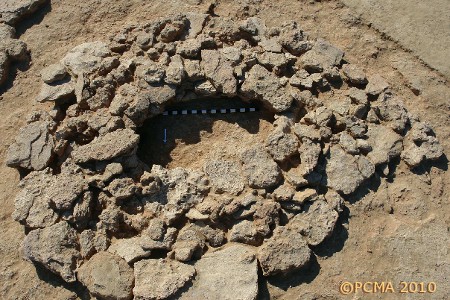
Tumulus SMQ 45 was chosen for exploration because it seemed to be the most prominent tomb in a cluster (SMQ 45–47) situated on a lower terrace to the southwest of the other graves. It turned out that this effect of prominence was the result of the mound, seemingly just under 1 m high, being constructed on a natural rise in the bedrock. The mound is oval in shape (8.50 m and 6.80 m across), while the burial chamber proved to be rectangular (0.85 by 1.25 m), just 0.40 m deep (as measured from the topmost stone), with solid bedrock for a bottom. It had been penetrated by grave robbers. A concentration of small and badly eroded human bones, probably belonging to a young adult, was discovered in its fill along with a few personal adornments.
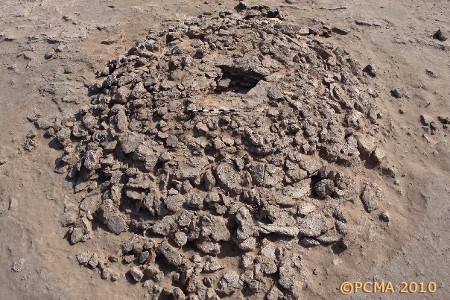
Mysterious stone structures
An oblong heap of stones rising only 0.30 m above the surrounding ground, SMQ 37, can be seen some 150 m to the northwest of tumuli SMQ 35 A–B. It is 8.10 m long and 1.30 m and 1.80 m wide at the southern and northern ends respectively. Vertical slabs sunk just 0.15 m into the ground form nearly 75% of the outer border. The shallow trench inside this outline is filled with stones in two to three layers. The top is flat. Another structure of the same kind, but poorly preserved, SMQ 36, was situated to the east of SMQ 35 A–B.
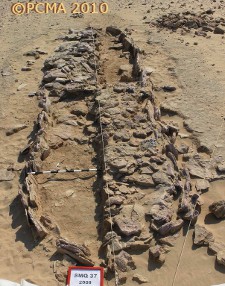
Another stone structure of unidentified function, SMQ 44, is situated at a certain distance from the tumuli. Its plan is roughly circular (maximum diameter approx. 2.60 m) and it has a rectangular annex (1.10 by 0.80 m) built into it on the eastern side and projecting 0.60 m to the outside. The western part of this annex is further subdivided by an upright slab. The bottom is lined with flat stones. Parts of the structure rest not on solid bedrock, but on a thick layer of sand. SMQ 44 did not contain any traces of burial. At this moment it is impossible to determine its function or the relationship between structures of this type and the tumuli tombs. It does look, however, that structures of this kind were usually located on the outskirts of clusters of tumuli.
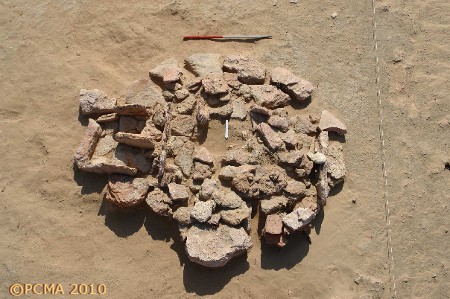
Desert well in the Muheita Area – site SM 12
Remains of a circular wall barely protruding from the sand attracted attention as it formed a roughly circular enclosure approx. 8.50 m in diameter. The wall, which was 0.40 m wide, was constructed for the most part in the dry-stone technique with occasional traces of red, clay mortar. A low bench stood against the inner face in the southern part. It was approx. 4 m long and 0.60 m wide, made of slightly larger stones than the wall itself and topped with a thick layer of red clay.
A round well was discovered in the middle of the enclosure. The diameter of the shaft at the top is approx. 3.20 m and judging by the inclination of the stone-clad wall, it must narrow substantially toward the bottom. Stones are missing from the top of the wall in the southern part and there is also a narrow recess in the inner face of the shaft where some flat stone slabs lie. They appear to constitute a form of rudimentary stairway leading down to the water level. The well was explored in quadrants to obtain full stratigraphic information. By the end of the season three quadrants had been explored to a depth of approx. 1.80 m, reaching some scattered boulders. The work will be continued.
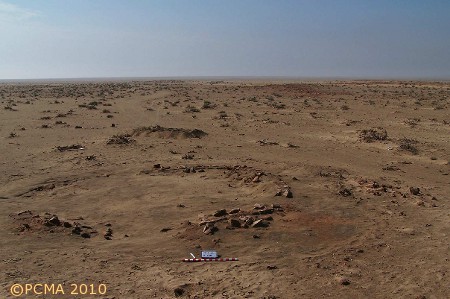
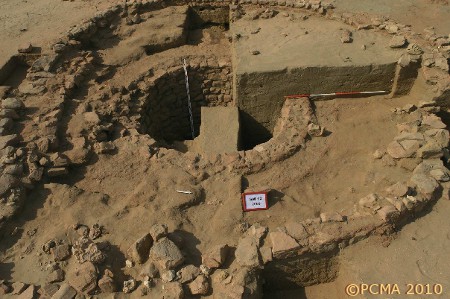
The low enclosure wall was obviously meant to protect the well against drifting sand and it offered amenities, like the bench, for users. Nothing that could date the structure has been found. The only significant find is the rim and neck of a medium-sized jar made of a gray fabric characterized by white grit as temper, found in the fill about 1 m below the top of the shaft. For the moment, however, this piece of evidence remains undated.
[Text: A. Szymczak, based on excavation reports]
